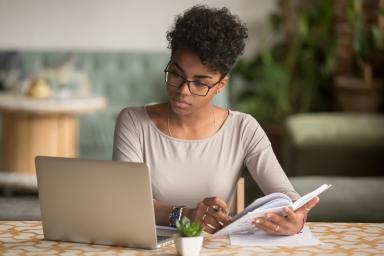Self Assessment – understanding payments on account
Paying your tax bill can seem complex, especially if you’re a new business owner going through the Self Assessment process for the first time.
With so many things to consider when starting your business, the deadline for your tax returns can easily sneak up, and you might end up paying too much, too little, or forgetting about it entirely.
New business owners also need to be aware of payments on account, a system created by HM Revenue & Customs (HMRC) to make paying any tax you owe more manageable by spreading payments out over the year.
What are payments on account?
Payments on account are advance payments on your expected tax liability for the upcoming year.
These payments are made in two instalments, and they’re calculated based on your Self Assessment return and your previous year’s bill.
They are designed to help budget your costs and avoid having a large sum to pay at the end of the tax year.
Payments on account apply to self-employed individuals who must submit a Self Assessment return, including sole traders.
As a self-assessed taxpayer, you’re required to make payments on account unless:
- your last Self Assessment return was less than £1,000
- 80% or more of your tax was deducted at source through PAYE.
How payments on account work
Payments on account distribute your future Self Assessment tax liabilities into two instalments.
HMRC calculates how much you should pay based on your previous year’s tax returns, and it divides the bill into two payments that must be made by:
- 31 January – for your first payment for the upcoming tax year, plus any additional tax you owe for the previous year
- 31 July – for your second payment that covers the remainder of the year.
These payments are typically divided evenly between both instalments, so if HMRC estimates that your tax bill for the upcoming year will be £1,000, you will be required to pay £500 by the end of January and £500 by the end of July.
At the end of the tax year, you make a ‘balancing payment’ to cover the difference between the amount you’ve paid and your actual tax liability.
You can see how that works in this example: Jane, a new business owner and sole trader, had paid £1,200 in taxes last year through income earned outside of PAYE, such as dividends or earnings working as a sole trader, so HMRC used this as the basis of her expected tax liability for the upcoming year.
She paid £600 on 31 January and another £600 on 31 July. However, a surge in customers over the year meant that she generated more income than expected and could pay herself additional income outside of PAYE.
After completing her Self Assessment return at the end of the year, she saw that her actual tax liability had risen to £2,000 taking into account the additional income, as well as other sources of income such as interest paid on personal savings.
She must now pay the extra £800 to balance her account by 31 January, and the first half of her new estimate – £1,000. On 31 July, she will pay the remaining £1,000.
Learn more about tax requirements for self-employed individuals.
What happens if I’m late with my payments on account?
HMRC charges interest on late payments to prevent businesses from gaining financial advantage by neglecting their tax return requirements.
However, it recognises that taxpayers might intend to pay on time but are unable to do so – as such, it offers a 30-day window to make a payment without suffering a penalty.
There are three late payment penalties, each equal to 5% of any unpaid tax on the penalty date.
- the first late payment penalty takes effect after 30 days
- the second late payment penalty takes effect after five months
- the third late penalty payment takes effect after 11 months.
Businesses are also subject to a £100 fine if they fail to complete their Self Assessment return, which HMRC uses to estimate payments in advance.
If the form isn’t filed after three months, this fine increases to £10 per day (up to a total of £900), while further fines of £300 can be issued after six months and a year.
Starting your own business? Find out how to register as self-employed.
What if I paid too much in payments on account?
There might be times when your sole trader revenue falls year-on-year – and because your payments on account are based on the previous year’s records, you will have ended up paying too much tax on account.
In these instances, you are still expected to make your payments on account, but you can claim a refund after you’ve submitted your tax return.
You can see how this works in the following example:
Steve is a sole trader and had a tax liability of £2,500 last year, so HMRC determined that he should pay the same amount this year – with instalments of £1,250 in January and July.
Over the course of the year, Steve actually earns less and pays himself a lower amount than the previous year outside of PAYE, meaning that his actual tax liability is £2,000.
After submitting his Self Assessment return at the end of the year, he sees he paid £500 more on account than he should have.
HMRC will confirm this and notify Steve that he can claim either a refund for this amount or deduct the overpaid money on account from any amount due from his latest Self Assessment submission.
How do I reduce my payments on account?
If you believe your tax liability will be lower than the previous year, you can ask HMRC to reduce your bill for the upcoming year.
You can do this if there’s a clear reason that your profits will fall, such as when:
- you are switching from a full-time to a part-time business
- you plan to retire
- your tax relief has gone up.
To make this request online, log into your HMRC account, view your latest Self Assessment return, and select ‘reduce payments on account’.
It’s important to note that if you incorrectly reduce your payments, you might be charged interest on the underpaid amount.
You can also apply by post by filling out the SA303 form and sending it to HMRC.
Tips for successfully managing payments on account
Payments on account can help businesses budget their money and ensure they’re not left with a single lump sum to pay in taxes at the end of the year.
But to make the most of this process, you might consider other ways to manage your cash flow and guarantee that you have the funds to make your tax payments on time.
For example, you might:
- Set up a direct debit –HMRC allows you to make automatic payments to ensure you don’t miss the deadline.
- Create a Budget Payment Plan – this helps you split your tax bill into even more manageable chunks, like weekly or monthly payments.
- Stay on top of bookkeeping – accurate and up-to-date financial accounts allow you to predict your tax liability and help you determine whether you need to budget for a balancing payment.
- Time invoicing – you can ensure a steady income by invoicing clients promptly and actively following up on outstanding payments.
- Submit your Self Assessment form early – it’s easy to make mistakes when you’re in a hurry to complete your tax return, but if you submit it early you have time to check your work.
By incorporating these strategies into your financial management routine, you can confidently navigate the Self Assessment and payments on account process.
Learn more about entrepreneurship with our free online courses in partnership with the Open University.
Our free Learn with Start Up Loans courses include:
Plus free courses on finance and accounting, project management, and leadership.
Tags related to this content:
Disclaimer: The Start -Up Loans Company makes reasonable efforts to keep the content of this article up to date, but we do not guarantee or warrant (implied or otherwise) that it is current, accurate or complete. This article is intended for general information purposes only and does not constitute advice of any kind, including legal, financial, tax or other professional advice. You should always seek professional or specialist advice or support before doing anything on the basis of the content of this article.
The Start-Up Loans Company is not liable for any loss or damage (foreseeable or not) that may come from relying on this article, whether as a result of our negligence, breach of contract or otherwise. “Loss” includes (but is not limited to) any direct, indirect or consequential loss, loss of income, revenue, benefits, profits, opportunity, anticipated savings, or data. We do not exclude liability for any liability which cannot be excluded or limited under English law. Reference to any person, organisation, business, or event does not constitute an endorsement or recommendation from The Start-Up Loans Company, its parent company British Business Bank plc, or the UK Government.
Your previously read articles
Sign up for our newsletter
Just add your details to receive updates and news from Start Up Loans
Sign up to our newsletter


